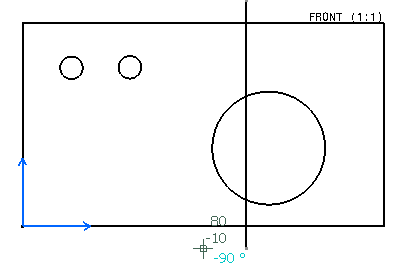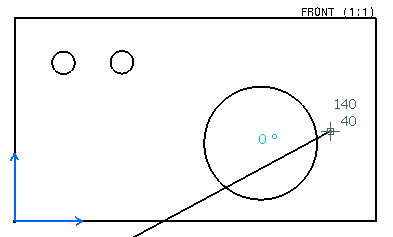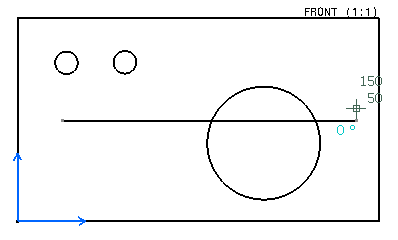Create a Section View / Cut Using an Offset Constraint by Selecting the First Point and the Direction of a Profile
While defining the section profile, if the first point of the profile segment is fixed and the direction is also fixed by applying one of the directional constraints (parallel, perpendicular or angle), then you can apply an offset constraint with respect to a hole as the reference element, to this profile segment.
For the purpose of this scenario, you will create an offset section view, but this capability is also available for other types of sections.
Click Offset Section View
 or Offset Section Cut
or Offset Section Cut
 in the Views toolbar (Sections sub-toolbar). in the Views toolbar (Sections sub-toolbar). The Tools Palette appears with only offset constraint:

You can create a profile before selecting the first point of the profile, by applying an offset constraint to the first segment with respect to a hole as a reference element. Refer to Create a Section View / Cut Using an Offset Constraint Before Selecting the First Point of a Profile for more information. Click to create the first point of the profile.
The Tools Palette
appears with the following constraint options:

For applying a directional constraint to the profile segment, you can select any one of these constraints: Parallel, Perpendicular, or Angle.
Notes:
- After selecting the first point of the profile segment, you can directly apply an offset constraint to a profile segment without constraining the direction of the profile segment, by selecting a valid edge or a hole as a reference element. Refer to Create a Section View / Cut Using an Offset Constraint Without Selecting the Direction of a Profile Segment for more information.
- If you select the offset constraint to define the first segment, then the offset constraint is the active constraint, else by default, the parallel constraint is the active constraint.
Click the appropriate constraint.
To set the direction of the profile, select one of the following valid reference element:
-
A generated line, such as an
edge, a center line or an axis line. In this case, the constraint will be associative
to the referenced 3D geometry.
- A generated circle. In this case, the constraints will be associative to the 3D.
-
One of the coordinates axis of the sheet. In this case, the constraint will not be associative to the 3D.
-
A sketched line. In this case, the constraint will not be associative to the 3D. Notes:
- An offset constraint for a second or higher profile segment (for aligned as well as offset sections) can be defined in two ways: either by applying an offset constraint with respect to a hole, or by creating an offset constraint with respect to a valid edge.
- For Offset Section views/Cuts, once you select the first segment, only the
Offset constraint button remains available in the toolbar. Click Offset and define the
subsequent segment by selecting a valid edge or a hole in order to
apply the offset constraint. Any edge that is parallel to the first
profile segment is a valid edge; all other edges are invalid edges.
After selecting the edge, the toolbar disappears.
- When selecting a valid edge, the offset value
is taken into account, and the current profile segment is
constrained with respect to the selected edge, at a distance equal
to the offset value in the same direction as that of the first
profile segment.
Click Offset and enter a value in the Offset: field. Select a circle as a reference element.

When selecting the circle, the offset value is taken into account. The segment keeps its original direction, but is also constrained at a distance equal to the offset value from the center of the selected circle. That is, an offset constraint (positional constraint) is applied to a profile segment which has been already constrained directionally.

Create a Section View / Cut Using an Offset Constraint Before Selecting the First Point of a Profile
When you activate the Offset/Aligned Section View or Offset/Aligned Section Cut command, the section profile toolbar appears, with only the offset constraint button available. At this point, you can either make a first selection by clicking anywhere in the sheet, or activate the offset constraint button, and select a circle to apply an offset constraint to the first segment with respect to the circle.
For the purpose of this scenario, you will create an offset section view, but this capability is also available for other types of sections.
Click Offset Section View
 or Offset Section Cut
or Offset Section Cut
 in the Views toolbar (Sections sub-toolbar). in the Views toolbar (Sections sub-toolbar). The Tools Palette appears with only offset constraint:

Click Offset and enter a value in the Offset: field. Select a circle as a reference element. The toolbar disappears. A profile segment is created such that its end-point corresponds to the current cursor position, the profile segment is tangent to a circle whose radius is equal to the entered offset value, and the center is coincident with the center of the selected circle.


Create a Section View / Cut Using an Offset Constraint Without Selecting the Direction of a Profile Segment
While defining the section profile, if the first point of the profile segment is fixed, but if the direction is not fixed, then, you can apply an offset constraint to this profile segment with respect to a valid edge or a hole as a reference element.
For the purpose of this scenario:
- You will create an offset section view, but this capability is also available for other types of sections.
- You will create an offset section view by applying an offset constraint with respect to a hole, but this can also be achieved by selecting a valid edge.
Click Offset Section View
 or Offset Section Cut
or Offset Section Cut
 in the Views toolbar (Sections sub-toolbar). in the Views toolbar (Sections sub-toolbar). The Tools Palette appears with only offset constraint:

Click to create the first point of the profile. The Tools Palette appears with the following constraint options:

Click Offset and enter a value in the Offset: field. Select a circle as a reference element. The toolbar disappears. When selecting the circle, the offset value is taken into account, and the segment is constrained in a horizontal direction, at a distance equal to the offset value from the center of the selected circle.

|
![]()
![]()




